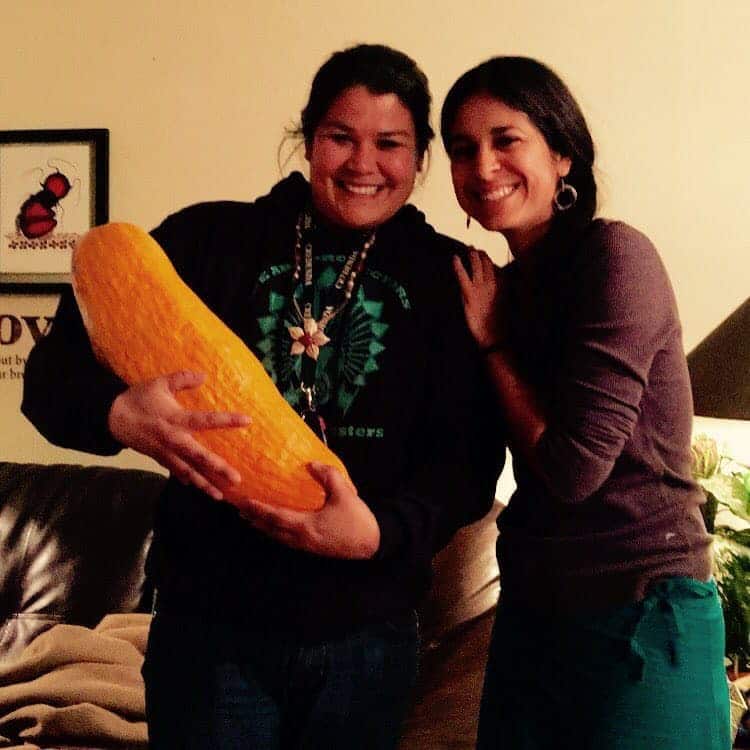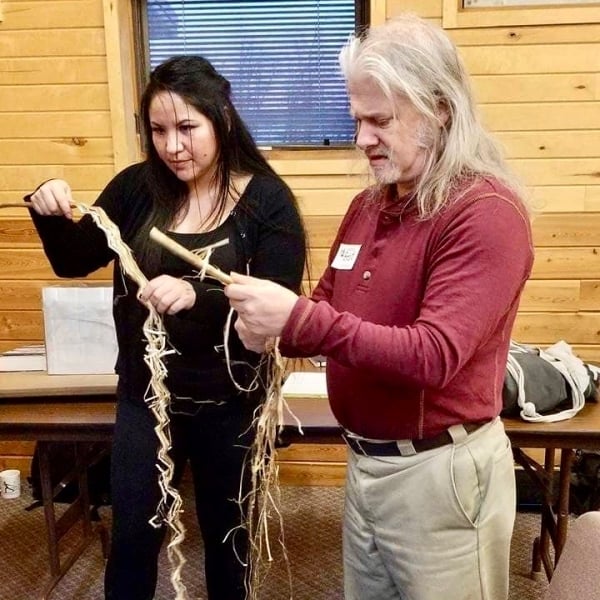
This past spring, I sat down over a cup of coffee with Winona LaDuke, an Anishinaabe woman who lives and works on White Earth reservation in Minnesota. On the patio of her beautiful home overlooking a small lake with loons singing in the background, she told me a little bit about her lifelong journey to protect her pristine homelands from industrial development.

A rural development economist by training, with an interest in the future of Indigenous communities and how they address the issues of food, energy and economic sovereignty, LaDuke hosted the first annual Anishinaabe Hemp Conference during the 15th annual Indigenous Farming Conference in Callaway, Minnesota in March. More than 25 indigenous herbalists, gardeners, horticulturists, community leaders, professors, students and farmers made presentations at the event this year.
LaDuke showed me some high quality hemp strains that she was quite proud of because they would soon make top-of-the-line CBD and fibre products. CBD, or Cannabidiol, is one of the 113 cannabinoids identified in cannabis plants. It is non-psychoactive and has been used to treat pain, anxiety, seizures, various skin conditions and more, though research on its effects is still in early stages.
“We would rather farm than have pipelines,” says LaDuke who is the founder of Winona’s Hemp & Heritage Farm. With an incredible lineup of presenters, the Anishinaabe Hemp Conference appeared to be a success as I witnessed alliances form between new and seasoned farmers, growing everything from hemp crops to the three sisters, also known as squash, beans and corn.
LaDuke spent most of her life fighting against Canadian companies such as Enbridge and Polymet. Her focus now is to stop fighting industries and start growing the next economy.
“We would rather farm than have pipelines”
LaDuke is also the director of Honor the Earth, an Indigenous-led non-profit organization that supports treaty rights, environmental and cultural protection and Indigenous economic sovereignty.
Speaking to a conference audience, LaDuke talked mainly about growing the next economy through hemp and Indigenous farming. But she also talked about her opposition to Enbridge’s Line 3 replacement project.
“It’s like I’ve been in a five-year dysfunctional relationship with Enbridge, and I want a divorce so I can focus on the next economy,” she says, recalling her recent battle against Enbridge’s Sandpiper pipeline and her current battle with the Line 3 replacement project.
Back at LaDuke’s house, we tried fish, maple syrup, maple sugar and wild rice — all Indigenous to the lands and lakes of the Anishinaabeg area. The foods have been an integral part of their economy since long before pipelines existed.
LaDuke talked about Enbridge’s Line 3 replacement project in more detail. The proposed pipeline will run from the Alberta tar sands, transporting crude oil through her home territories in White Earth and Leech Lake, Minnesota, to the Husky Energy oil refinery in Superior, Wisconsin. (The refinery exploded and caught fire in April 2018, validating some of LaDuke’s concerns.)
The wild rice beds, which LaDuke also harvests, have grown naturally in Anishinaabeg territory in Minnesota for many centuries and requires only the protection of the watersheds in which they grow. LaDuke prides herself in being a water protector. A top-of-the-list priority for her is protecting the rivers and lakes in which the rice grows.
LaDuke is among others in Minnesota who oppose the Line 3 replacement project. Their community has spent over five years fighting Enbridge and their proposed Sandpiper pipeline, which was made public in 2013 and was withdrawn in 2016. Minnesota residents successfully sent the pipeline packing, and were among few communities who have seen a pipeline construction area empty out before a pipe is ever put in the ground.
On the heels of their victory comes the proposed Line 3 replacement project. In Edmonton, LaDuke says she “saw nation after nation of people [Indigenous and non-Indigenous] coming in and talking about how they couldn’t drink their water anymore.” Six months later Enbridge announced Line 3. “So I said no, we’re not going to do that,” says LaDuke.

The wild rice beds and harvesting in this area are protected under the 1837 Treaty with the “Chippewa” (better known as the Anishinaabeg) and have been a part of their economy and way of life for thousands of years.
“I started researching and realized that the company had a lot of spills,” referring to spills such as the one on Enbridge’s Line 6B pipeline near the Kalamazoo river, which was one of the largest inland oil spills in American history, second only to the Grand Rapids, Minnesota, oil spill in March 1991.
“What I realized is that you have 50-year-old pipelines and instead of cleaning up their old pipelines they want to bust a new corridor and start abandoning. And that sets a dangerous precedence,” says LaDuke.
Wrapping up our visit at her house, LaDuke says, “I realize that [Enbridge] is the third largest corporation in Canada … so we’re standing ready [to oppose construction through Minnesota]. We’re standing ready at the pipelines, we’re standing ready at the [Minnesota] border.”
In Treaty Four territory in Saskatchewan, residents start preparing for the Canada-wide legalization of cannabis for recreational use. As the dispensary lottery is announced, void of any significant First Nations representation, there are many recent discussions happening about cannabis and what that means for growing the Indigenous economy.
LaDuke also joined us as the keynote speaker for the Congress of Humanities and Social Science 2018 event at the University of Regina. She was on the panel for the Bringing Back the Buffalo workshop discussing the buffalo, hemp economic opportunities and, of course, Enbridge’s Line 3 replacement project.
The life givers
Many tribes and First Nations across Turtle Island (also known as North America), were matriarchal societies, meaning that the women and grandmothers made many of the decisions and carried many of the teachings. They were once governed through teachings that came from the relationship between a woman and the land.
These teachings were also expressed through the words of the other presenters during this conference and are still alive today, as Indigenous women are being reintroduced to their roles as keepers of the lands and keepers of the knowledge.
Glenda Abbott was one of the 25 presenters at the hemp conference.

Abbott, who is a Nehiyaw woman from Pelican Lake First Nation in Saskatchewan, talked to participants about Nehiyaw (also referred to as Cree) cosmology, women, water and seeds.
The presentation opened many other discussions that come back to the life givers, or the mothers, and the Indigenous way of life in the Western Hemisphere pre-colonization.
Abbott’s teachings are in midwifery, food sovereignty and understanding the role of Indigenous women as caretakers of the lands.
Abbot’s presentation served as a teaching tool that showed the relationship between the abuse of the lands and the abuse of Indigenous women — an observation that many tribes across the continent are pointing out as Indigenous women continue to suffer abuse and have gone missing near industry projects and transient worker areas known as man camps. This connection between the abuse of Indigenous women and the abuse of Indigenous lands was a connection that each of the presenters pointed out as they urged the reclamation of way of life and matriarchal teachings as a tool to help heal the land and the nations.
Listening to both of these ladies speak with ancestral pride and ancestral knowledge was very empowering and enlightening. I listened to them describe their life’s work summed up in planting, harvesting and creating life. Despite everything that was meant to erase Indigenous women, they continue to be driven by their relationship and responsibility to the land and the passing of matriarchal knowledge.[end]
This piece was edited by Wawmeesh Hamilton, with fact-checking and copy editing by Jonathan von Ofenheim.
Brandy-Lee Maxie is one of reporters participating in The Discourse’s Local News Fellowship. The fellowship aims to support sustained coverage of issues related to energy and the environment in communities underserved by the media.
[factbox]
While you’re here…
In Canada, nearly 250 media outlets have closed in the past decade.That’s why The Discourse is stubbornly dedicated to building a new kind of journalism that serves people, not advertisers.
Because Canada needs journalists to provide accurate and unbiased information about polarizing issues, to reflect Canadians’ diverse perspectives, and to hold power to account.
We can only build the new media Canada needs with your help. Support The Discourse to contribute to journalism that’s having an impact. Pay what you can — it only takes a minute. Thanks.
Become a member of The Discourse
[/factbox]



